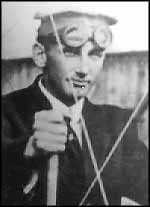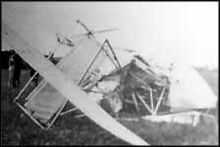Frank S. Scott
| Frank S. Scott | |
|---|---|
 U.S. Air Force photo | |
| Born |
December 2, 1883 Braddock, Pennsylvania, US |
| Died |
September 28, 1912 (aged 28) College Park Flying Field, MD, US |
| Allegiance | United States |
| Service/branch | United States Army |
| Years of service | 1908–1912 |
| Rank | Corporal |
Corporal Frank S. Scott (December 2, 1883 – September 28, 1912) was the first enlisted member of the United States Armed Forces to lose his life in an aircraft accident.
Early life
Born in Braddock, Pennsylvania, Scott was orphaned in 1889 after his parents died in the Johnstown Flood; he was thereafter raised by an aunt.
US Army
Corporal Scott's military career began at Fort Slocum in 1908 in the Field Artillery branch of the US Army. Scott later cross-trained into the Signal Corps in 1911. In July 1911, Scott began suffering from a lengthy unknown illness and upon recovery was deemed unfit for his current duties and was forthwith transferred to College Park Flying Field. After arriving at his assignment, Scott discovered a penchant for mechanical engineering and was reassigned from his duties of releasing hot air balloons to becoming chief mechanic for one of the Type-B Wright biplanes assigned to the Field.
On September 27, 1912, Scott was promised a ride in one of Flying Field's airplanes by First Lieutenant Lewis C. Rockwell. Retired Captain Bernard Rome spoke with Corporal Scott the same day and noted that "He was in high spirits when I spoke to him," and that, with regards to his flight the next day, "...Scott jokingly referred to himself as 'ballast'." Corporal Scott had secured the ride on the aircraft as opposed to what would normally be an officer's position because of his low weight — having never fully recovered from his illness of 1911.

The next day, Lieutenant Rockwell test-flew the plane alone to ensure proper functioning; after reaching 40 miles per hour (64 km/h) and assured that the aircraft was functioning properly, the Lieutenant landed and picked up Corporal Scott. The takeoff and flight itself were uneventful as the small craft flew at an altitude of 150 feet (46 m) for about ten minutes. However, when attempting to land the plane, Lieutenant Rockwell begin to develop problems with the engine; the 30 horsepower (22 kW) engine failed sufficiently to cause the airplane to lose its lift and crash soon thereafter. The crash that took both Corporal Scott's and Lieutenant Rockwell's lives was witnessed by over 300 people.
On July 20, 1917, following the procedure for naming American military aviation fields after Airmen who died in service during "the experimental era", the base now known as Scott Air Force Base, Illinois was officially designated Scott Field.
References
- "Corporal Frank S. Scott". Scott AFB History Office. 2006-04-17. Retrieved 2006-08-31.
- "Scott air force base history". Archived from the original on 2007-08-15. Retrieved 2006-08-31.
See also
- List of accidents and incidents involving military aircraft (pre-1925)
| ||||||||||